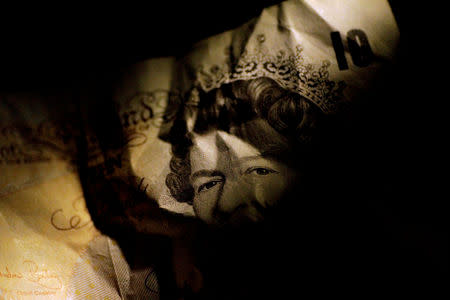Uncertain Brexit endgame keeps big sterling bets off agenda
By Tom Finn and Saikat Chatterjee
LONDON (Reuters) - London and Brussels are nearing the Brexit endgame, but sterling may be subject to big swings regardless of whether they soon cut a deal - keeping investors looking to bet on the next big direction for the currency on their toes.
The pound rose last week to a one-month high against the dollar on hopes the two sides were close to a breakthrough, easing fears of a 'no-deal' British exit from the bloc next March.
But sterling traded back at one-week lows on Monday <GBP=D3> amid a stalemate over the post-Brexit status of Britain's land border with Ireland, puncturing optimism before an EU summit on Wednesday.
Even if May and EU authorities reach agreement, a likely second battle with her own party in London over that issue - the biggest outstanding hurdle - has generally left investors wary of taking big cash sterling positions.
"I wouldn't be rushing to buy sterling. We could easily see the pound at $1.15 or $1.45," said Derek Halpenny, European head of global markets research at MUFG.
The scenario of binary Brexit outcomes has prompted mainly caution.
The British currency has traded mostly in a range of 86 to 90 pence against the euro <EURGBP=D3> over the last year. It has swung more violently versus the dollar but that's probably down to the greenback's own volatility in 2018.
Taking out protection against sterling losses, via three- and six-month options contracts providing a hedge against a 'no deal' Brexit has been a popular trade.
For now, there is no sign of this picture changing.
Many of May's lawmakers who want a cleaner break from Europe, and Northern Ireland's DUP, the party she depends on for her parliamentary majority, have threatened to vote against next year's budget, potentially bringing down her government.
Such events could bring "months of up and downs for sterling," MUFG'S Halpenny said.
BAD NEWS PRICED IN?
Over 80 percent of strategists in a recent Reuters poll predicted sterling to be higher in a year than its current $1.32 levels because so much bad news is already priced in.
But between now and then, much seems uncertain.
Three-month sterling implied volatility, a gauge of future fluctuations, is approaching its highest levels this year at more than 9 percent, far above implied vols on euro and Japanese yen and even higher than some emerging market currencies.
Around $1 billion worth of sterling options expire at the end of this week, Refinitiv data shows. They are bunched around $1.28-$1.32, roughly the range sterling has traded in since May.
The final chance for May of reaching a deal during 2019 now appears to be a summit in December, but optimism is limited - for instance, only 38 percent of Nomura's clients said in a survey they expected a deal by year-end.
Meanwhile speculative positions remain broadly negative and derivatives continue to signal nervousness. Futures data shows short pound positions by hedge funds remain near-17-month highs of $4.97 billion.
Another sign traders are bracing for sterling weakness comes from risk reversals <GBP3MRR=> <GBP6MRR=>, a gauge of the difference in demand for puts - betting an asset's price will fall - and calls - betting it will rise.
The most liquid three-month risk reversal is at the widest since September 2016. In other words, bearishness on sterling is at its highest in two years.
"Even if we see a deal, the upside for sterling will be around 5 percent from current levels but risks for a sharp drop in the pound have also grown substantially as can be seen from FX derivatives," said Charles St-Arnaud, a senior investment strategist at Lombard Odier Asset Management in London.
That concern is also manifest elsewhere in options markets where demand has risen for out-of-the money puts on the British currency, especially against the euro. Such puts tend to be relatively cheap because their strike prices are below current market levels.
"The possibility of an early election, a referendum, or prolonged standstill all remain very real," said George Saravelos, co-head of foreign-exchange research at Deutsche Bank, who estimates the chance of a deal passing parliament at 50 percent.
(Reporting by Tom Finn and Saikat Chatterjee; Editing by Sujata Rao and John Stonestreet)

 Yahoo Finance
Yahoo Finance 

